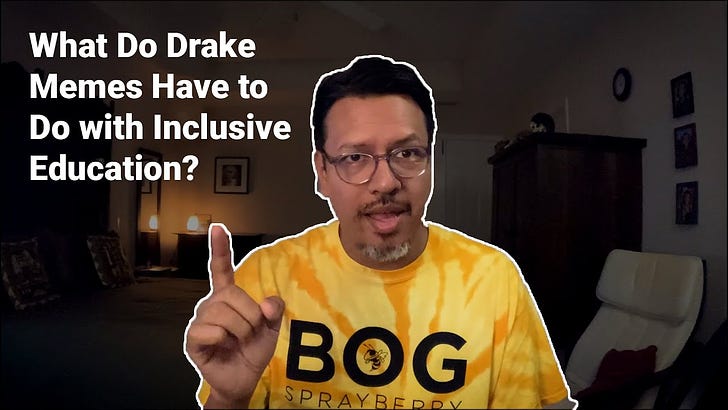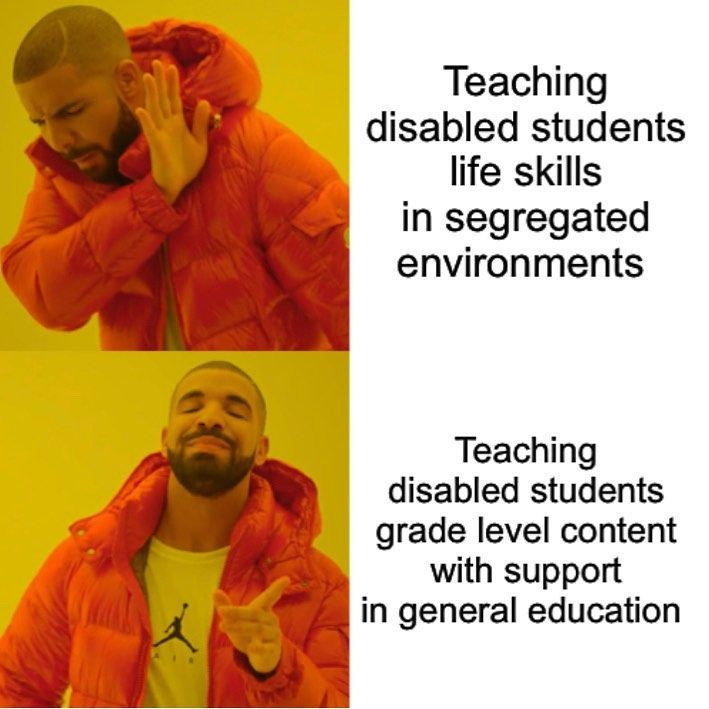What Do Drake Memes Have to Do with Inclusive Education?
Memes are never perfect. But at least this one got us talking about inclusive education.
Just for some context, we posted a Drake meme on the socials this week and got some pushback.
Here is the meme.
[Disclaimer: This meme/post is to contrast a larger point about segregated versus inclusive classrooms. Not to be taken as something Drake literally said.]
Image Description: Drake meme. In the first frame, Drake is holding up his hand disapprovingly at the phrase “teaching disabled students life skills in segregated environments.” In the second frame, Drake is looking approvingly at the words “teaching disabled students grade level content with support in general education.”
It’s amazing how quickly people come to defend segregated special education classrooms when they are challenged. Because, honestly, they aren’t that great.
I should know. I taught in one for 13 years before moving to a district-level support position. And then, for three years, I supported students and teachers in segregated special education classrooms.
I’ve observed countless segregated classrooms, special education teachers, and students with disabilities. And well-run, respectful, student-centered, community-focused classrooms were few and far between. Though I will admit that they are out there.
Do you know what the common denominator was for classrooms that struggled? There were too many diverse support needs in one classroom to effectively support all students.
Doesn’t that sound familiar? This is often the argument for why inclusive education doesn’t work. But if you are a regular reader of The Weeklyish, you know that packing students with disabilities in one general education classroom isn’t inclusive, it’s just bad educational practice.
In response to our Drake meme, one person wrote:
Actually teaching students with sensory overload in large classroom settings disasterous, but I do agree that goals should be ambitious. [sic]
Agreed. So maybe part of the answer is to make all classrooms accessible for all learners by distributing students with diverse support needs across all classes? When we are scheduling for students with disabilities in the same classroom, why don’t we take that into account? There is nothing that says we need to put all the students with IEPs in one classroom and call it the inclusion classroom. That ain’t inclusion!
Here is another comment:
My son needs to be in a smaller room. He struggles in giant, overpacked, highly stimulatory classrooms. Trying to fit him into the ‘grade level content’ has caused him to feel like a failure because he isn’t grade level for a lot of his work. You cannot teach all the children one way… nor can you teach a child all the ways. You need to teach a child in a way they feel safe and connected with. And if that means a room that is disconnected from other classrooms… then so be it. Each child is different.
Here is the problem with the idea that a smaller room is going to fix a student feeling like a failure. A classroom isn’t going to give them that support, a teacher (or team) is. And no matter if the student is in a small, medium, or large classroom, their teacher sets the tone of the class. This kind of support can and is being done in inclusive classrooms and schools.
The same goes for this idea that inclusive education is one size fits all. It is the exact opposite. In inclusive schools, specially designed instruction is not a curriculum, it is a set of strategies to adapt the content, methodology, or delivery of instruction. How is that one size fits all?
If by one size fits all, you mean all students in a general education classroom without the appropriate supports where everyone gets the same lesson at the same pace with no differentiation… Then yeah. Of course. I don’t like that. But that isn’t inclusive education.
Look, this meme is not perfect. Some people pointed out that the term disabled was not defined. Was it talking about people with physical or intellectual disabilities or both? What does it mean by “life skills?” Don’t we all need life skills? What does the term “with support” mean? Isn’t that just putting a paraprofessional next to a student with a significant disability?
All of the disagreements on this Drake meme thread, in my opinion, come down to a misunderstanding of what we are talking about in regards to inclusive education.
Decades of research show better outcomes for people with disabilities when they are included, and authentic inclusion is happening in schools and districts around the country and the world (some nearing 90% inclusion rates or above for many years). Knowing full well that percentages of placement are only one indicator of inclusive practices. This progress did not just happen but is the result of careful planning led by educational visionaries and the implementation of strategies that promote effective inclusive education.
Maybe all of this resonates with you. Maybe you are an inclusionist. To us, “inclusionist” means a fierce collaborator for inclusive practices, not simply someone who wants to throw the whole system away without replacing it with something better.
That is what we are trying to do with this newsletter. To show people there is a better way not only to educate students with disabilities. But all students.
Maybe you have questions about what inclusive education would look like for your child or students. If you really want to know, reach out and ask us. We may not be able to reform your school system, but perhaps we could provide some ideas on moving the inclusive education needle where you are right now.
Have a great week everyone!
- Tim
ICYMI
Labor Day Is Cool. But Disabled Workers Are Still Being Left Behind.
The Decision to File for Due Process
(Podcast) Genia Stephen | Good Things In Life Podcast
In The News
Educators see struggling students. After a pandemic year, do they need extra help or services for a disability?
States may be in violation of federal laws prohibiting discrimination against students with disabilities when they limit school mask mandates.
There are not enough special education teachers.
The National Center on Disability and Journalism at Arizona State University has released an updated version of its disability language style guide.
What I’m Reading

What I’m Watching
What I’m Listening To
What’s in my Timeline

From the Wayback Machine
Seeing Inclusion in Action Can Be the Spark to Systems Change
The bottom line is that “students in segregated self-contained classrooms [do not] get the same education as general education students in regular classrooms,” said Jacques Smith, a former middle school administrator and Board President of MCIE.
Teachers “are charged with teaching multiple subjects, you don’t have a regular Math [or ELA] teacher, and when students go to special areas they usually [are] not trained or prepared on how to work with students with disabilities,” Smith continued.




